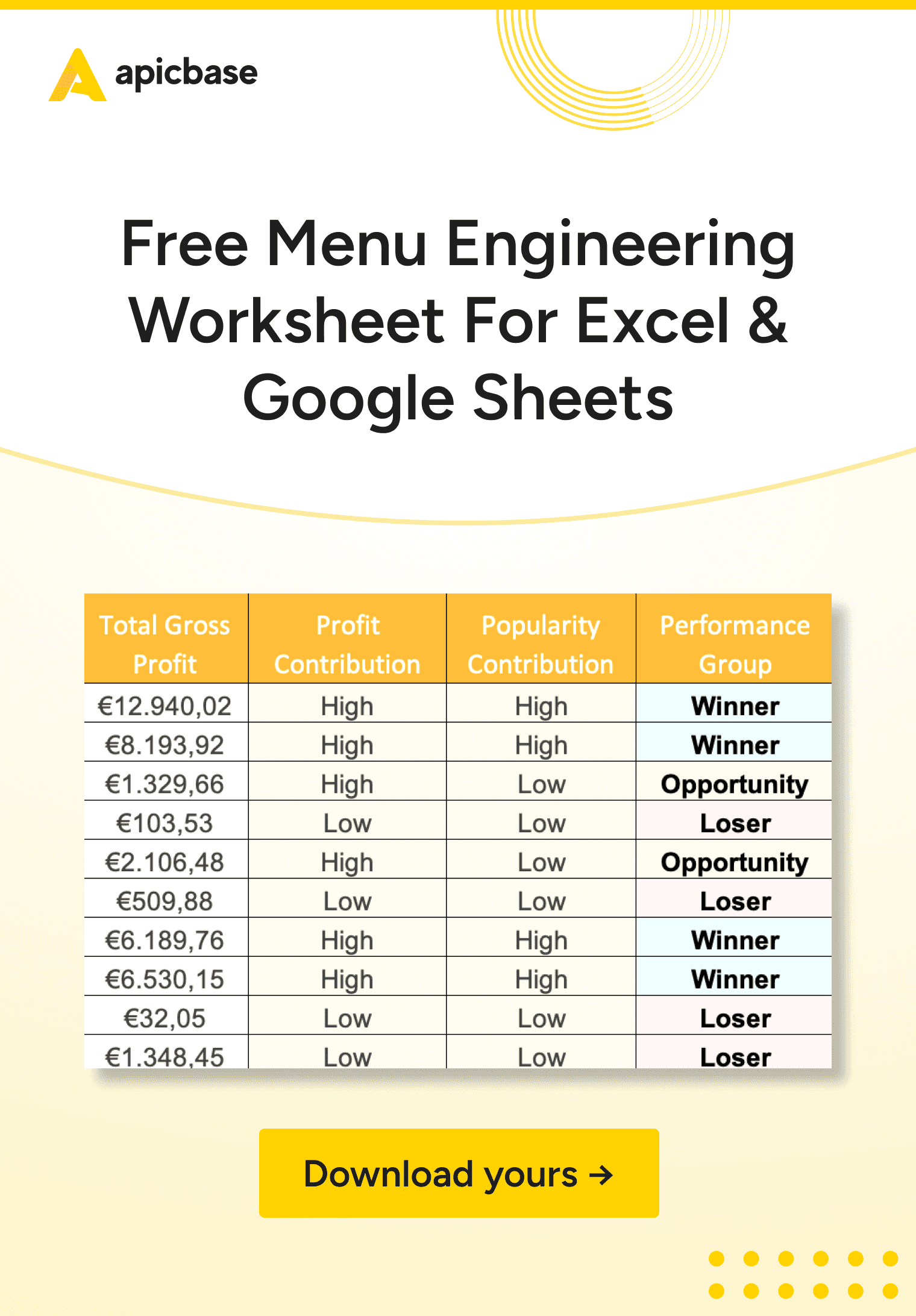Is your approach to menu engineering limited to periodic redesigns and minor pricing adjustments? If so, you’re missing out on significant revenue opportunities.
Menu engineering is far more than a prelude to visual tweaks and price corrections—it’s a strategic, ongoing process that can unlock substantial profits. Consistent menu engineering can add between 10 to 15% to your bottom line. So when you ignore its full potential, you leave bags of money on the table.
In this post, you’ll learn how to leverage menu engineering insights to make every item you offer a solid winner over time. We explore how to boost profits with menu tweaks, kitchen staff training, and vendor negotiation tips.
But before diving into restaurant menu engineering, it’s essential to highlight an obvious yet crucial step: developing cost-effective recipes. This is the foundation of everything. It ensures every dish appeals to your target customer and delivers healthy margins.
Advanced recipe development software helps your corporate chefs and R&D team build:
- fully costed recipes that
- balance profitability with operational feasibility, considering
- ingredients,
- allergens,
- nutritional values,
- Nutri-scores and
- carbon footprints.
Recipe development and menu engineering are closely related. Some might even say they are the same thing. However, for the sake of clarity, we discuss menu engineering as the process that begins once recipes and menus go live.
In this article, we cover the following topics:
- What is menu engineering?
- How to run a menu analysis
- Why actual food cost percentages matter
- How to get access to a running sales mix report
- What improvements to make to increase menu popularity & profitability
- Why testing menu changes is important
Let’s start with a definition of menu engineering and learn how to categorise the F&B items you’re offering in your restaurant or catering operation.
What is Menu Engineering?
Menu engineering is the process of optimising menu building and pricing to increase the overall profitability of an F&B operation. This process helps restaurant operators — all of whom sell items of varying popularity and profitability — maximise profits per guest by tweaking operations, staff training, and menu design.
Often, you’ll see this process represented by the end result — the sales mix matrix (also called the menu engineering matrix):
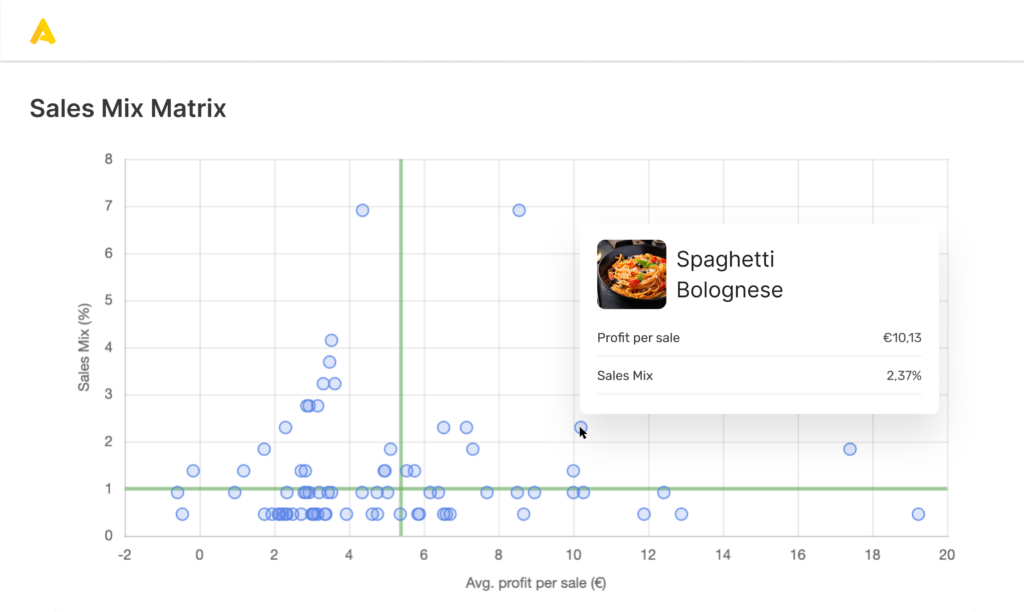
The matrix immediately shows your best sellers and unprofitable items by placing them into one of four menu engineering categories:
- STARS: highly popular/highly profitable
- PLOW HORSES: popular but not very profitable
- PUZZLES: profitable but not popular
- DOGS: not popular/not profitable
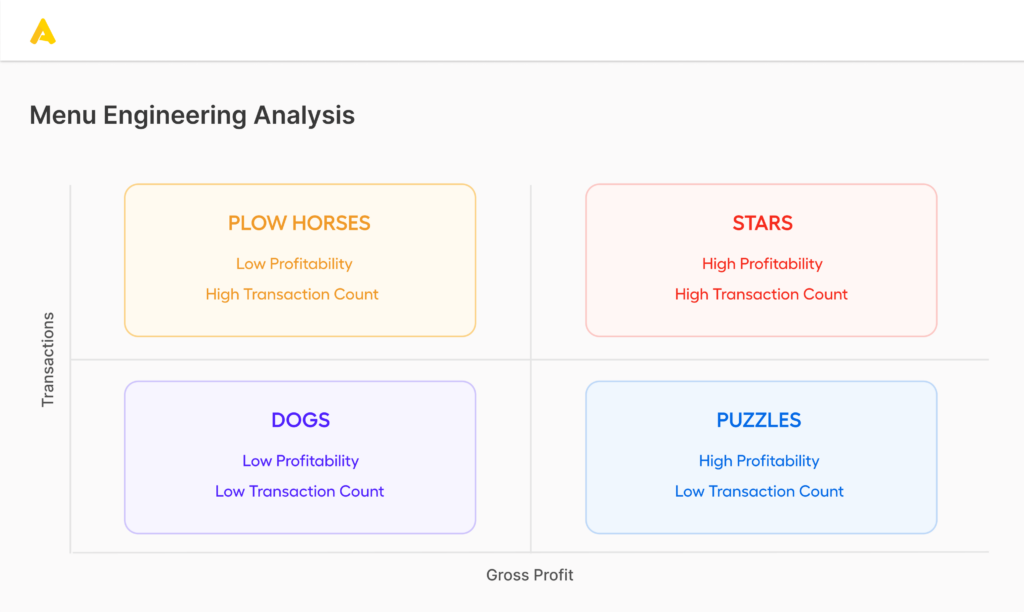
In an ideal world, you want everything you offer to land in the top-right quadrant. These items are above the average contribution margin and well above the 70% popularity baseline.
That’s where the money is.
Unfortunately, the restaurant industry world is far from ideal… and that’s why staying on top of things matters.
The truth is that the F&B industry is getting more volatile by the day.
You have to perfect your menu engineering if you want to stay ahead of rising inflation, out-of-control supply chains, and rising labour costs. Every percentage point you add to the profit side protects your business from sliding into the red.
And your work starts with the cornerstone of menu engineering — menu analysis.
“My best advice for menu development is simplicity”, says Michael Evan Schatzberg. He’s a restaurant operations specialist from New York. “Simplicity equates to scalability, low labour costs, consistent product, lower COGS and less food waste. Creating a fun and flavorful menu is easy, but profitable, operable, and scalable is a different story.”
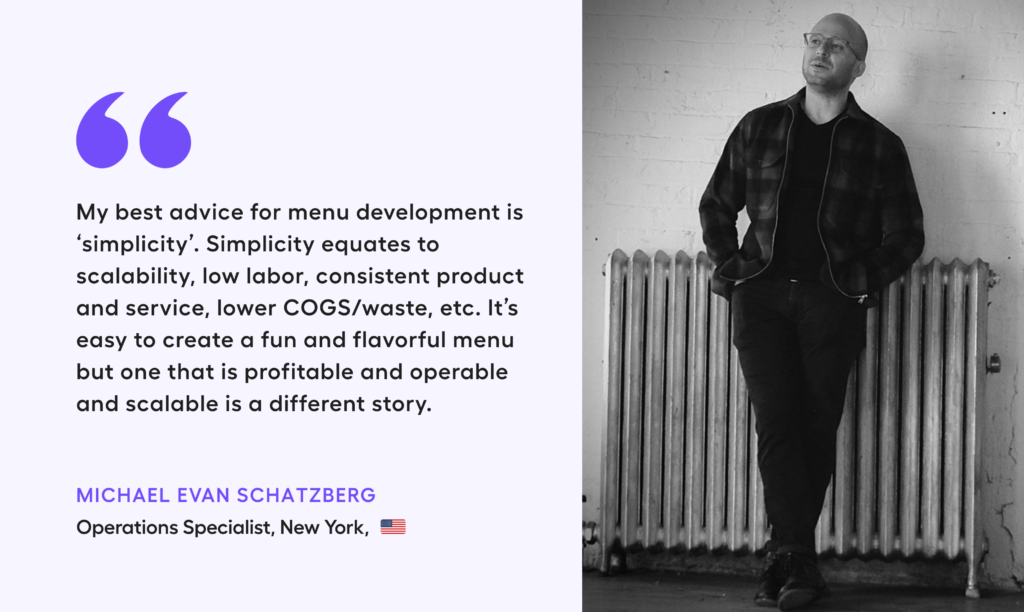
How To Do Menu Analysis & Sales Mix Matrix Manually
A manual analysis involves a bit of math.
Not much… but enough to work on a menu engineering worksheet and create an accurate sales mix matrix.
Here’s an example of that worksheet:
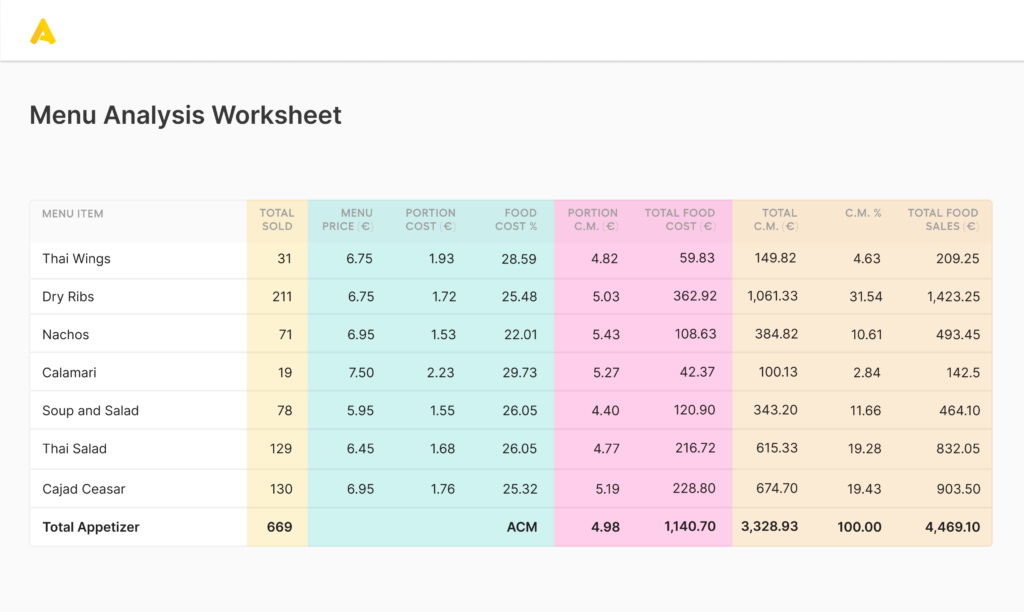
These figures show you your menu prices and how much your menu items cost and yield. The menu engineering worksheet (aka menu analysis worksheet) lists all the data you need to make impactful decisions — total sales per item, estimated food cost, portion cost, and contribution margin. This info will help you determine the profitability and popularity of your restaurant menus.
Grab the ready-made worksheet below for a quick start👇

[Free Download] Menu Engineering Worksheet
Don’t start from scratch. Download a ready-made online menu engineering and worksheet with formulas. Automate your menu calculations. Create profitable menus and identify opportunities, losers, workhorses and winners among your recipes.
The ‘totals sold’ help you gauge item popularity. It informs the y-axis of the menu engineering matrix. The higher up the item falls, the more popular it is.
To get to the popularity threshold, divide 100% by the number of items in the menu you’re analysing. That’s your ‘expected popularity’ per item. It’s a theoretical number, but it gives you something to go on. The number distributes ‘popularity’ evenly among menu items, totalling 100 for the entire menu.
Everything that is 70% or above of that ‘expected popularity’ is considered a popular menu item. Similarly, this is a theoretical number, but it gives you a solid benchmark.
Formulas for Expected Popularity and Threshold Popularity
The formulas are:
- Expected Popularity = 100%/#menu Items
- Popularity Threshold = Expected Popularity x 70%
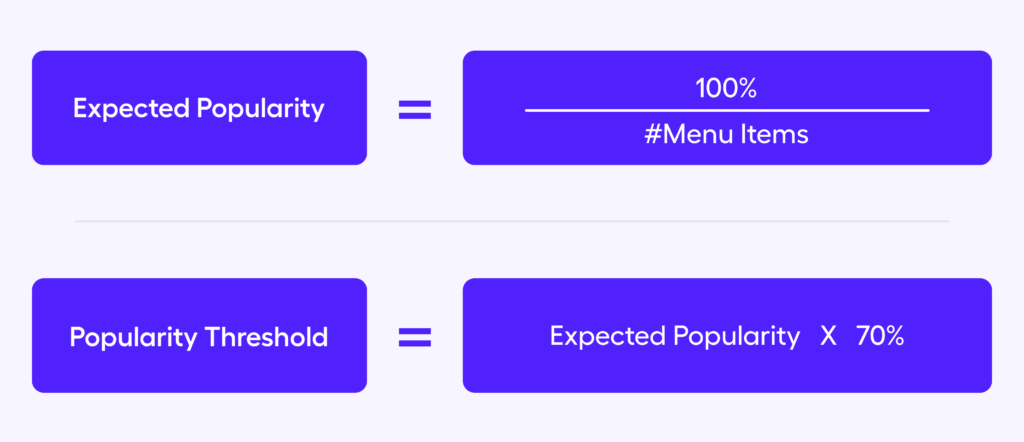
Examples
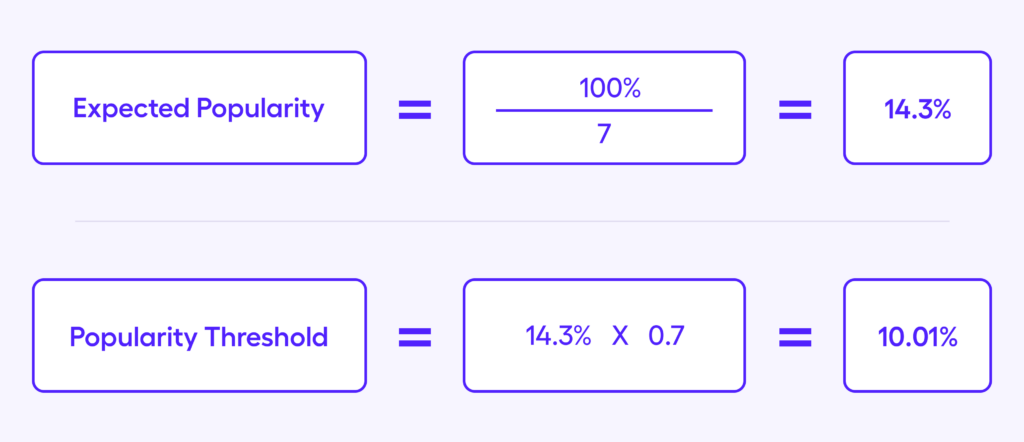
- Expected Popularity = 100%/7 = 14,3%
- Popularity Threshold = 14,3% x 0,7 = 10,01%
The only unpopular items in the worksheet above are calamari and Thai wings, which account for 2.84% and 4.63% of the 10% total sales threshold, respectively.
The next step is where you look at profitability.
The contribution margin shows you your most profitable menu items. The x-axis [profitability] is informed by the contribution margin. It tells you how much each menu item contributes to your bottom line (after taking out standard food costs).
You get to the relative profitability of an item by comparing its contribution margin (CM) to the average contribution margin (ACM) of the menu in question. You calculate the average contribution margin by dividing the total contribution margin by total sales.
Formulas for Contribution Margin and Average Contribution Margin
The formulas are:
- Contribution Margin = Menu Item Price – Portion Cost
- Average Contribution Margin = Total Contribution Margin/Total Sales

Example
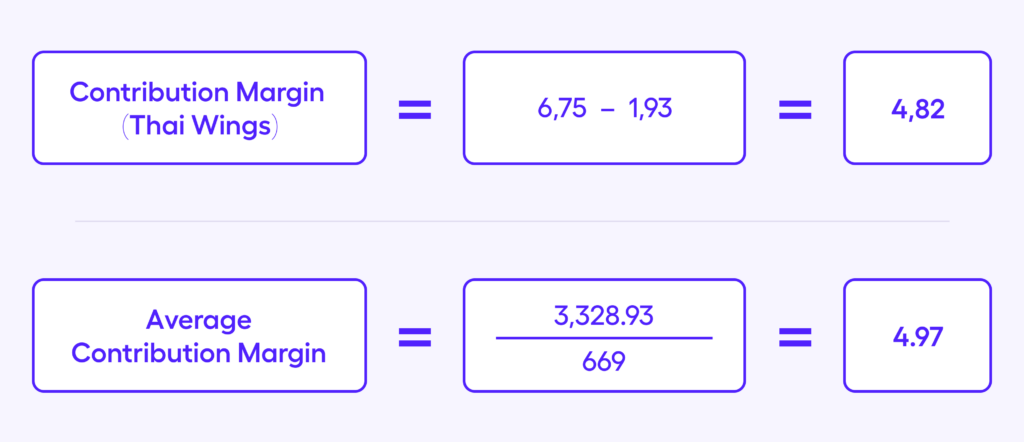
- Contribution Margin (Thai Wings) = 6,75 – 1,93 = 4,82
- Average Contribution Margin = 3.328,93/669 = 4,97
As you can see in the Menu Analysis Worksheet above, Thai wings, Thai salad, and soup and salad dishes do not pass the profitability test. Their portion CM is below the € 4.97 ACM.
TIP: when calculating profitability, group thematically connected dishes or categories
Why? As you can see, sometimes ¢10 to ¢20 is all it takes to flag a dish as unprofitable. To get the most accurate picture of how your restaurant menus perform, compare apples to apples. This means separately analysing your breakfast, lunch, and dinner menu price categories.
Analyse with a clear goal in mind. That way, you don’t accidentally delete things that are on the menu for another reason – such as increasing the average ticket amount – just because the maths tell you to.
An excellent example is appetisers—most have a borderline contribution margin compared to mains and entrées but cost zero in labour and contribute to revenue growth. That’s why you analyse them separately.
Once you’re done with this basic menu analysis, you can plot your items on the matrix:
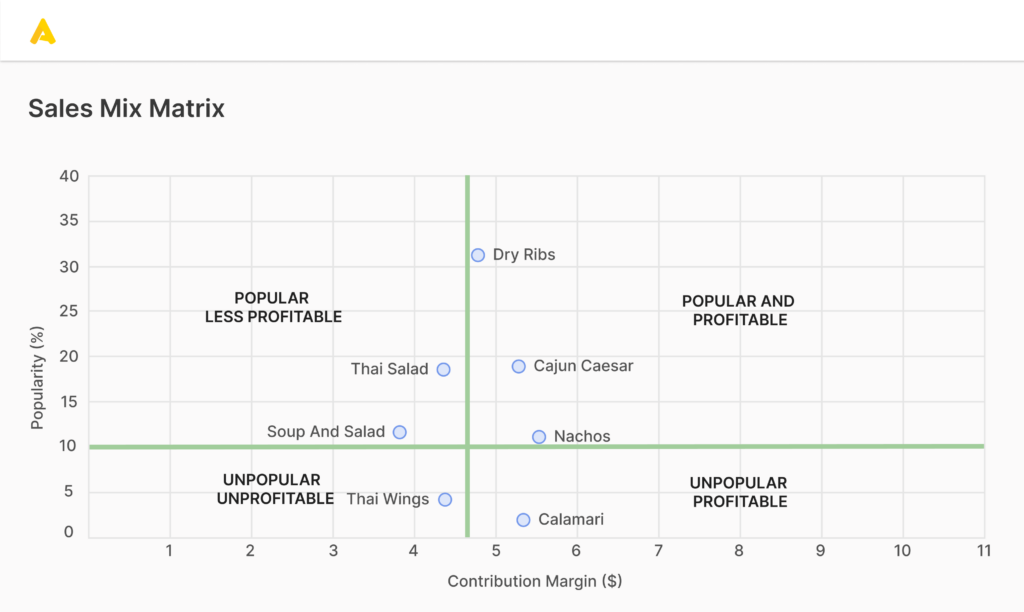
Alternatively, you can present this information in a four-box analysis:
| UNPROFITABLE | PROFITABLE | |
| POPULAR | Thai Salad, Soup and Salad | Dray Ribs, Cajun Ceasar, Nachos |
| UNPOPULAR | Thai Wings | Calamri |
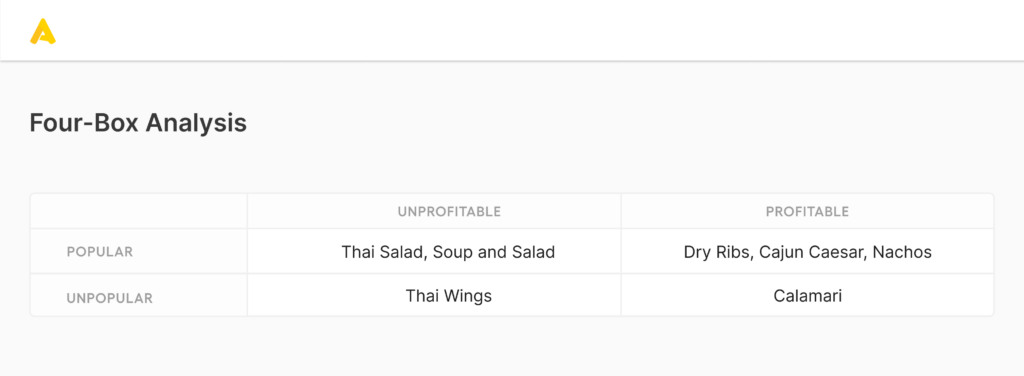
You’re now ready to make data-driven menu decisions.
Simple, right?
Well, it definitely would be… if those annoying food costs stopped changing every hour.
Why Are Food Costs & Recipes Costings Important for Menu Engineering?
Looking at the profitability calculation above, one thing is abundantly clear — menu engineering can’t be done [or at least can’t be done right] if you don’t know the cost of your ingredients down to a tee.
That’s where costed recipes come in.
In most F&B operations, costed recipes become obsolete quickly. They’re either done periodically or worse when you set up your operation… and then never again.
But food costs — the cornerstone of your costed recipes — change daily. Food waste, poor plating, theft, and vendor price changes affect food costs and, by extension, impact your portion cost.
“We use data tools to analyse order volume and demand to build a menu that makes the best use of the available ingredients, equipment and people to eliminate waste”, says Sam Martin, COO and co-founder of Peckwater Brands.
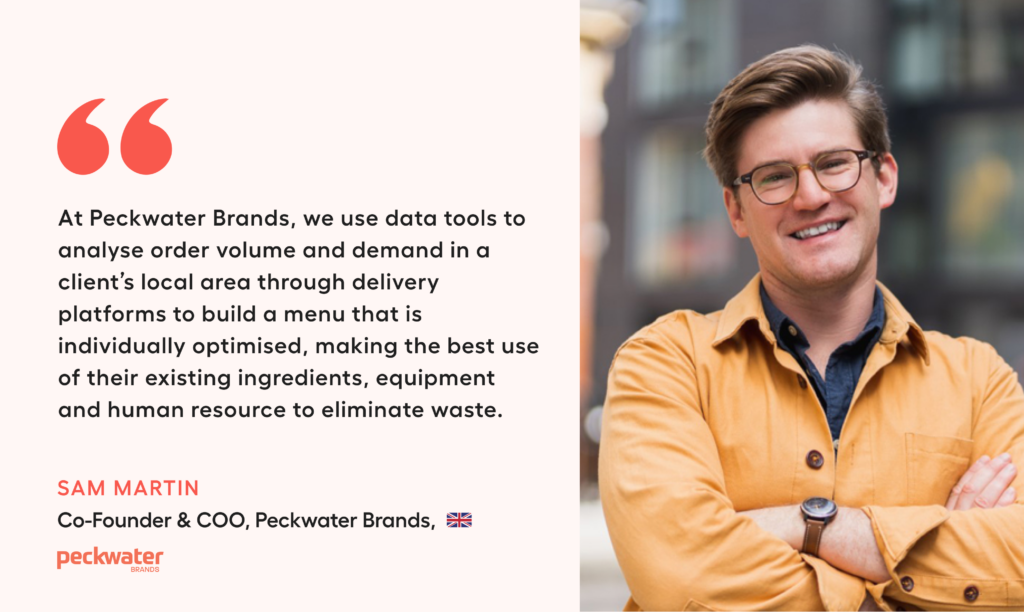
If you’re not keeping tabs on your actual food cost percentages — if you’re not course-correcting and adjusting costed recipes on the fly — you can’t get to the correct portion contribution margin. And you can’t know with certainty which of your items are profitable… and which are not.
Some F&B operators and restaurant owners combat this by redoing all their recipe costings and calculations before running a menu analysis. But this takes time and is unreliable — the more people you have working on this, the bigger the chance that an error will creep in.
A better approach is to update your costed recipes automatically. For example, Apicbase integrates with your suppliers to automatically update ingredient prices, recipe costings, and margin calculations. Your team receive a notification when a dish’s margin drops below your predefined threshold, ensuring you can take prompt action to maintain profitability.
Apicbase connects all your back-of-house processes — supply chain, inventory, recipe database, and production. The system knows how to catch food cost variations, account for them, and then update costed recipes as needed. As a result, all downstream calculations (contribution margin included) are super accurate.
Make Menu Decisions On the Fly With Apicbase
As you’ve seen, manual menu engineering involves a lot of number-crunching. It takes time, so you can’t do it as often as you would want (or need).
With Apicbase, you can say goodbye to time-consuming calculations and once-per-year menu pricing tweaks that cost you money. Simply link Apicbase to your POS (for access to your sales data) and your vendor side (or update manually whenever there’s a price change), and you’re set.
To see your sales mix matrix — with all your stars, plowhorses, puzzles, and dogs already plotted — all you need to do is visit your sales analytics dashboard in Apicbase. Once there, you’ll select a time period and a predefined menu, et voila! — your sales mix matrix is done… and you can now make impactful menu decisions.
Optimise Menu Categories Using Data
Now that you’ve identified your menu profit drivers and your menu slackers, it’s time to make decisions that will boost your bottom line.
While I encourage you to read up on menu psychology and apply it when doing menu engineering, it shouldn’t be the only thing you do when striving for profit improvements. Training your servers, strategically rethinking vendor relationships, and getting creative in the kitchen can go a long way towards running a popular and profitable F&B operation.
Here are some menu best practices you should try.
Get Everything out of Your Menu Stars
- Maintain quality — don’t significantly alter any of the components of these dishes, and keep ingredient quality high. Substantial changes can reduce the popularity of an item.
- Increase price — this is a balancing act — don’t go overboard with price increases because you’ll decrease the item’s perceived value [and its popularity].
- Train staff to get descriptive when selling — train your servers to sell stars with a flare [if needed, provide a script]. It’s not ‘basil sauce’’… it’s ‘a house basil sauce made from locally grown herbs following the chef’s grandmother’s recipe’. Descriptive and evocative sells.
- Rethink menu placement — your stars should have a place of honour on your menu — middle, top left, or top right are the sweet spots [the so-called golden triangle]. Use visual cues [borders, colours, images] to draw attention to these items, but avoid clutter.
- Reexamine vendor relations — double-check where your ingredients are coming from. If the main ingredient of a star menu item is sourced from a single vendor, think about what you can do to get a better deal. Maybe you sign a long-term contract with more favourable terms. Transfer extra orders to that vendor to secure better prices. Or settle your invoices in under 30 days to qualify for a discount. Whatever you can do to lower costs per portion will result in a higher contribution margin.
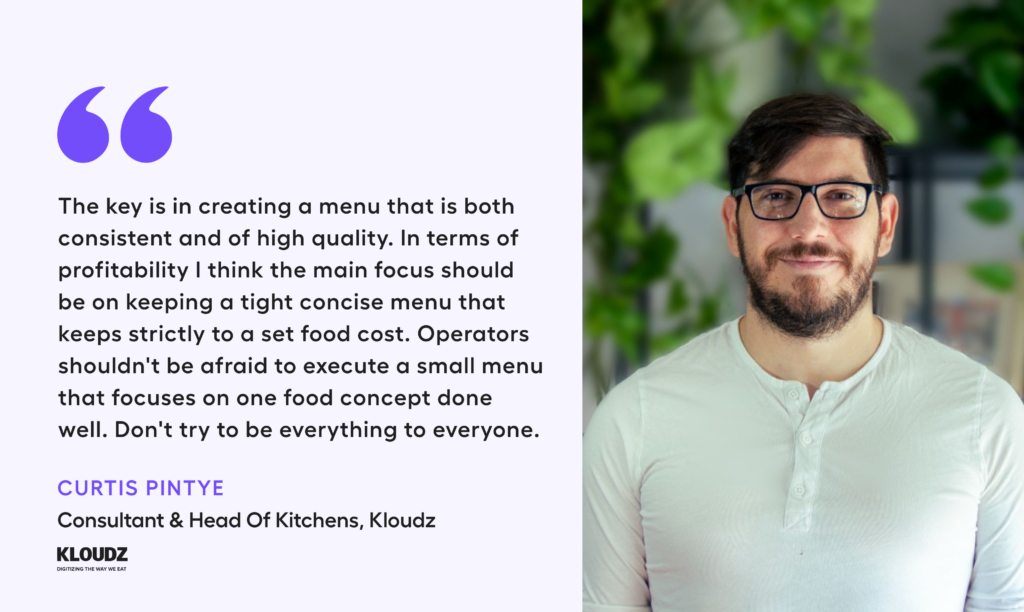
For Curtis Pintye, consultant and head of kitchens at Kloudz, the key is creating consistent and high-quality menus. “In terms of profitability, the main focus should be on keeping a tight, concise menu that sticks strictly to a set food cost. Operators shouldn’t be afraid to execute a small menu that focuses on one concept done well. Don’t try to be everything to everyone.”
Transforming Plowhorse Items into Menu Stars
- Increase price — the goal here is to increase profitability without making a dent in the menu item’s popularity. The best way to do that is to test gradual price increases over an extended period.
- Lower portion cost — decrease portion size if possible, and try different lower-value accompaniments — a side of cheaper, seasonal vegetables might work just as well as something more expensive.
- Create a low-cost combo option—add a contribution-margin-boosting side to the dish for which customers can pay extra. Dishes that work best here are made from leftovers and have low labour costs.
- Train staff to offer premium accompaniments. With popular menu items, servers should strive to increase cheque size by offering premium side dishes and beverages. They should also always look for opportunities to cross-sell appetisers, entrees, and desserts.
- Decrease visibility — if you can’t do much to increase the profitability, you should consider moving it to a less prominent part of your menu [think of it as reverse menu psychology]. This way, you’ll open up valuable menu real estate for more profitable dishes.
- Renegotiate vendor prices — as with the stars, look at what you can do about ingredient prices to shrink your costs. If you can shave 5 to 10 per cent on the cost side of things, you’ll start breaking even.
Solving Puzzles & Boosting Their Popularity
- Test menu positions — test different menu placements: the golden triangle positioning and callout boxes are good places to start. Also, going all-in on evocative descriptions might help some customers choose a dish they otherwise wouldn’t because of their unfamiliarity with it.
- Decrease price — consider decreasing the price of a puzzle menu item to see if that will increase the sales.
- Increase portion size — or, alternatively, switch to better accompaniments and garnishes. Doing this can increase the perceived value of the dish, making it more appealing to your diners.
- Actively promote — consider promoting some puzzle dishes via your marketing collateral [location posters, table stickers, or in-restaurant displays]. Run a combo special to test how customers respond to increased value/offer variety. Include an experiential component [for example, tableside preparation].
Knowing When To Delete Your Dogs [& When to Keep Them On]
In most cases, these menu items are ideal candidates for removal from the menu — nobody is ordering them, and even if they do, you’re losing money on them. For example, due to inflation and rising COGS, 54% of restaurants report having cut menu items. However, there are times when you might have to keep them on. If that’s the case, consider moving them to a less valuable spot on the restaurant’s menu and keep their total costs low [prepped from leftovers and minimal labour involved] so you’re not taking too big of a hit.
Agile Menu Engineering = Rethinking The Fundamentals
Many modern F&B operations are ditching physical menus in favour of digital price lists [e.g. all virtual restaurant brands]. Shorter feedback loops associated with digital let you quickly test any menu changes without the cost of printing. This non-reliance on paper makes menu engineering incredibly agile and valuable because you can roll out tweaks [new photos, new item names, or new ingredients] overnight… and iterate as many times as you want without wasting money and time.
But… does this mean that you can’t leverage menu engineering if you’re using printed menus?
Of course not.
You can do a lot to boost profitability even if you don’t redesign your menus [physical or digital]. Consider menu engineering an opportunity to hone processes and make creative kitchen decisions that positively impact your profit and loss statement.
If you do want to re-do your physical menus, do a test run. Roll out the new menu design in a handful of locations, use printed daily menu inserts to see how your customers respond or experiment with digital menus.
Start small before going big. Platforms like Apicbase’s restaurant data analytics software offer a daily treasure trove of data that can boost your bottom line—take advantage of it and make profitability improvements your weekly goal.
Apicbase’s Menu Engineering Software Lets You Work the Magic Every Day
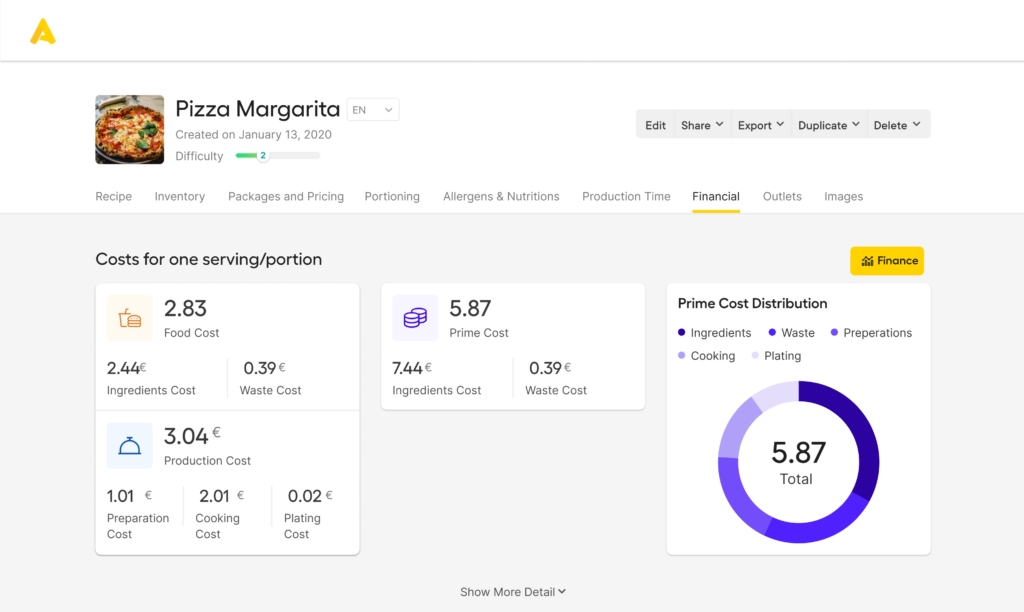
Effective menu engineering isn’t part art and part science. It’s all science.
Instead of guessing which dishes to keep or remove from your menu, use sales and restaurant inventory data to make informed decisions. A menu analysis will show you which dishes to improve, promote, or remove. Automate the menu engineering process to update your menu regularly, ensuring every dish is popular and profitable.
With Apicbase’s menu engineering software, you can monitor actual food costs to keep your recipes accurate. This provides a real-time overview of your contribution margins, allowing you to react quickly if an item falls below its desired profitability level.
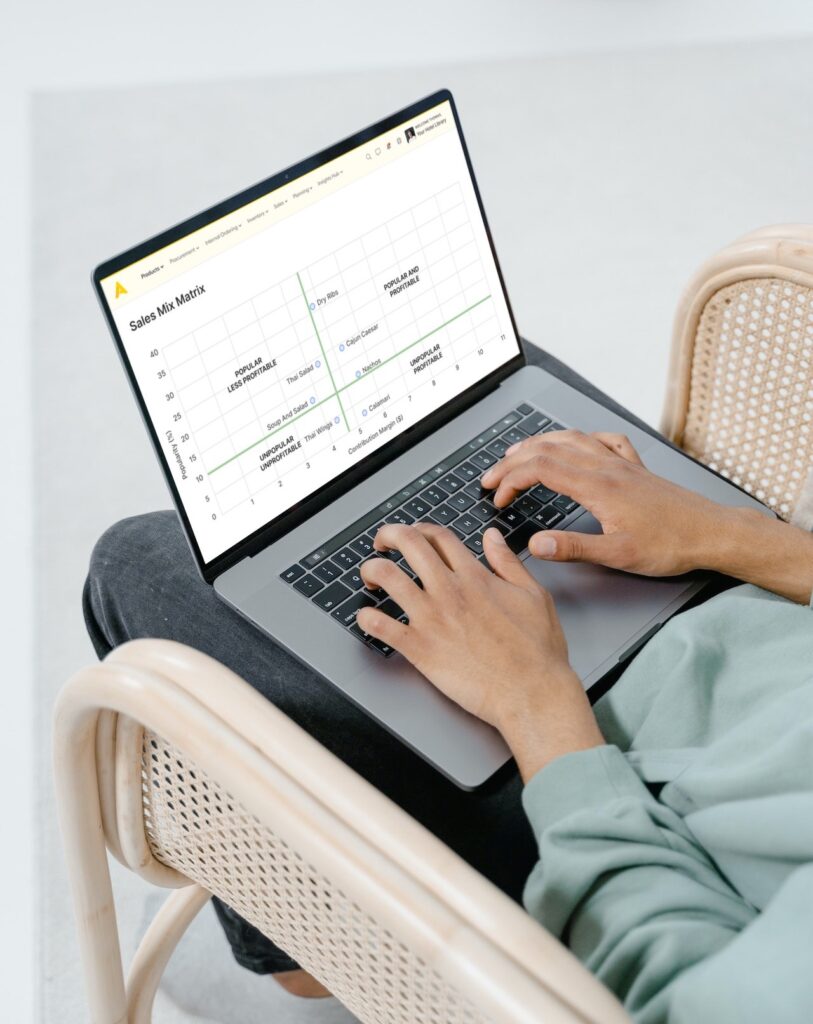
See Apicbase’s in Action
Easily monitor real-time sales and inventory. Your corporate chef and menu R&D team can easily drag and drop ingredients from the supplier databases to create cost-effective recipes and track their performance on an intuitive menu dashboard.


